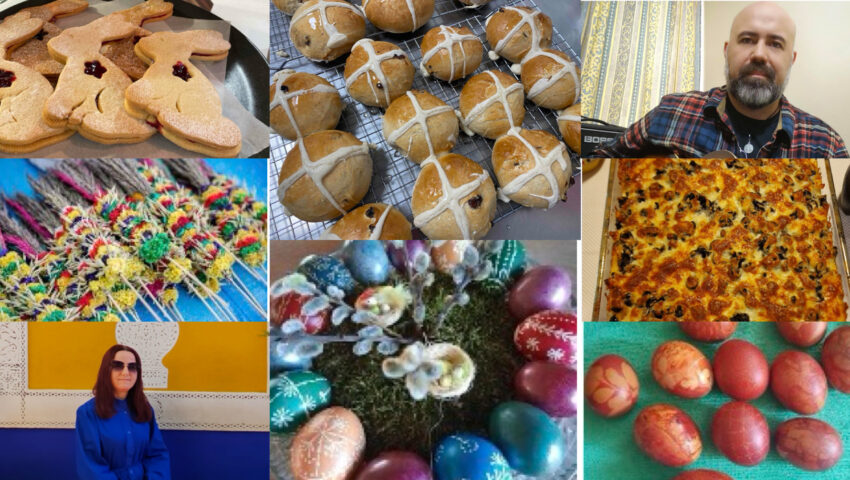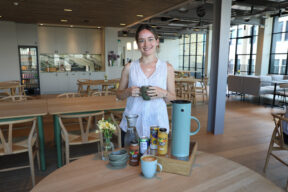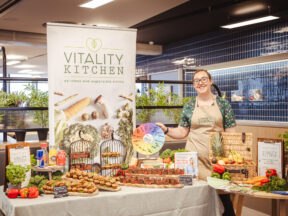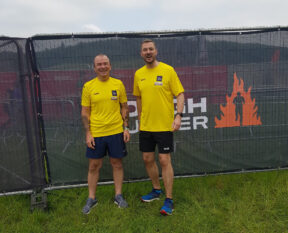Blogs
Easter celebrations: a tapestry of tradition

Easter is a time of celebration and reflection, marked by diverse traditions around the world. Members of the #bmFamily💜💚 have taken some time to share their Easter traditions.
Poland: A Fusion of Faith and Folklore
Palm Sunday and Holy Week
Easter in Poland is celebrated according to the Western Roman Catholic calendar. Easter Sunday falls on the first Sunday after the first full moon of spring. Rites and practices are therefore marked by Christianity but remain strongly influenced by pagan traditions. It is usual for both modern and conservative families to partake in the celebrations, regardless of what their religious beliefs may be.
The first sign of approaching Easter in Poland is a large number of branches and dried flowers being brought to church. One week before Easter, Palm Sunday (in Polish niedziela palmowa) takes place. According to Catholic tradition, the day marks the entrance of Jesus in Jerusalem. Since palm trees are rare in Poland – churchgoers often bring pussy willows or ‘palms’ made of colourful woven dried branches.
The Holy Week preceding Easter involves spring cleaning. In the countryside, people would use the occasion to repaint their barns. Religious fasts are sometimes observed in varying degrees of strictness. Families visit representations of the tomb of Christ, often decorated spectacularly for the occasion.
Egg Painting and Easter Baskets
On the Saturday before Easter Sunday, Poles paint hard-boiled eggs (called pisanki). Egg painting is encountered in several other Slavic cultures and is thought to date back to pagan rituals that are over 5000 years old.
Another Saturday activity is the preparation of the Easter Basket. Lined with a white linen or lace napkin and decorated with sprigs of boxwood (bukszpan), the baskets contain a sampling of Easter foods: pisanki, a piece of sausage or ham, salt and pepper, bread, a piece of cake and an Easter Lamb made of sugar or even plastic. They are brought to church to be blessed.
Easter Sunday: A Joyous Feast
On the most important day, Easter Sunday, some go to church at 6am for the Resurrection mass – a ceremonial service and procession. Homes come alive with families who gather to eat breakfast. Before the meal, in much the same way as for Christmas with the sharing of the opłatek (Christmas wafer), people share wedges of the blessed Easter eggs from the basket. They exchange wishes and a Wesołego Alleluja (Joyful Hallelujah).
The breakfast is dominated by cold dishes and is a feast for meat lovers: ham, sausage, roast meats, pâté (pasztet), eggs, horseradish relish, and bread.
What follows is a frenzy of Easter cakes: a tall, round 15-yolk sweet yeast cake with a hole in the middle (babka) and Mazurek – a cake with a thick layer of icing, decorated with dried fruit, walnuts, almonds, roasted seeds; or Sernik – a classic Polish cheesecake.
Śmigus-dyngus: A Playful Finale
The last festive day is Easter Monday, known as Śmigus-dyngus (Wet Monday), on which tradition requires that boys throw water over girls and spank them with willow branches.
Magdalena
Easter in Lithuania
Since my childhood days Easter was and still is the most sacred time of the year. I have such fond memories of travelling with my parents to my grandmother’s house (she lived in a small village) where we would start preparing for the celebration, painting eggs, helping to prepare food, having an Easter Sunday feast and playing Easter games.
Passing on Traditions
- Most Lithuanians are Roman Catholics and the Easter ritual starts with “the Great Lent” which lasts 40 days.
- Then, 1 week before Easter, we have Palm Sunday which commemorates Jesus Christ’s entry into Jerusalem. On that day Lithuanians make “Verbos” which represents Palm branches.
- These “Verbos” are made from different dried colourful flowers, willow branches, hay, and dried cereal stems. These are taken to the church to be blessed and brought home for protection.
- Holy Thursday was a day for ritual cleaning – not just yourself but everything in the house, windows, walls, and clothes had to be in a clean pristine condition.
- Good Friday people try to be quiet, children were not allowed to make noises in respect for Jesus’ suffering. On that day people don’t consume meat, milk or dairy products. Some choose not to consume any food at all.
- Holy Saturday people go to church so they can bring home some holy water and fire (lighted candles). They believe it has miraculous powers, provides protection and can cure illnesses.
- In the evening we paint eggs. There are a few ways it can be done but the most popular is to dye eggs with natural products like onion skin, cabbage leaves, beetroot, turmeric, flowers or to use hot wax to make a beautiful ornament (using a pin). Painted eggs(colours) symbolise the suffering of Jesus.
Easter Sunday
Easter Sunday-after Easter morning church service people rush home (those who get home first will be lucky in achieving and finishing jobs early in the coming summer) and break their fasting by eating blessed Easter egg (some people take other food items to the church to be blessed), some sip Holly Water. Even now in our house, the first meal on Easter is “painted egg” (which we do ourselves every year). And then the feast starts with all the foods which were forbidden during Lent – on a crispy white tablecloth people lay out roast pork, roast chicken, sautéed sauerkraut with pork sausages, herring salads, black pudding & potato sausage, pickled cabbage soup, dishes made with eggs, freshly made white cheese, desserts like poppyseed roll and cookies, sweet Easter bread, apple and sweet cheesecake. Wash everything down with a malt drink or apple juice with caraway seeds. And of course, there has to be a basket with Easter eggs, for everyone to choose their egg.
Easter Games
Easter games are popular to play with your family. One game is “egg cracking/tapping” – one person(called the holder) holds the chosen egg and another person is called the tapper, they tap one egg to another. The one whose eggshell remains intact, wins and also means they will have good health that year.
Another game is “egg rolling” – Players lift one end of a rounded tray made from bark, wood or cardboard at an angle from the ground. They roll an egg down the tray trying to tap another player’s egg in turns. If they succeed, as the reward they collect both eggs. The person who collects the most eggs – wins.
Ingrid
Modern Paganism – The festival of Spring
In modern Paganism there really are no great commandments or rules other than respect for nature yourself and your fellow human. In pre-medieval paganism, The festival of spring was known as Ostara, named after the Anglo-Saxon goddess Eostre goddess of new beginnings.
The celebration of spring is present in many ancient customs, across all cultures, and it seems that paganism has borrowed from many of them for Ostara. Like many other spring celebrations in other cultures, Ostara symbolises fertility, rebirth, and renewal. This time of year marked the beginning of the agricultural cycle, and farmers would start planting seeds.
Symbols of Ostara
Many of the symbols of Ostara have roots in other traditions, and the use of rabbits and hares is one such example. In medieval times in Europe, the March Hare was seen as a fertility symbol and a sign of spring. This species of rabbit is nocturnal most of the year, but in March, it is mating season for the animal. During mating season, March Hares are seen all day long. Additionally, females of this species can get pregnant with a second litter while pregnant with their first litter. This explains why they were used as symbols of fertility. It’s interesting to note the historical use of the March Hare in the British Isles seems to have grown into what children might know of today as the Easter Bunny.
Many modern pagans might go outside to meditate and perform a simple ritual or offering to welcome the spring. Another common way to celebrate the coming spring is to plant seeds. Some families incorporate seasonal sweets with their kids to help them get in the spirit of the event. Gardening, baking, gathering to feast, and enjoying a fire are all fine methods of celebration for the festival.
Easter in Brazil
Easter Sunday holds great significance for my family back in Brazil. While some of us hurried to church early for Palm Sunday, the little ones were already dreaming about the chocolate eggs awaiting them at home. Living in the UK, I don’t have many family members, but I do have very good friends who have become my family here, and we keep the tradition of exchanging Easter eggs alive. Easter eggs were more than just treats; they symbolise love and affection, exchanged among family members and friends.
And then there’s the food!
From the sweet Paçoca, made with crushed nuts, flour, sugar, and salt, to the savory ‘bacalhau,’ a form of salted cod served in various ways, it was a feast. But, most importantly, Easter is about family, friends, laughter, and making memories together.
Cassia
Catholic Traditions
I’m Roman Catholic, and my traditions are very close to the Orthodox, Anglicans, and most of the Christian beliefs. The Jews also celebrate Easter, but for a different reason than the Christians.
Jewish Celebration
The Jews celebrate when they were set free from slavery in the Egyptian Empire. The Christians celebrate the resurrection of Jesus Christ. The word “Easter,” which is “Pascoa” (Portuguese), Pascua (Spanish), Pasqua (Italian) comes from the Hebraic word “Pessach,” which means “pass through.” The Jews, while fleeing from Pharaoh’s troops, passed through the middle of the Red Sea, which opened a passage through the waters… Passed from slavery to freedom. Jesus passed from death to life, 3 days after being murdered on the cross… Spiritually, this means everyone who believes in him will also “pass through” the “death state” (sins) to Eternal Life (grace).
Lent
We Catholics start getting into the Easter spirit 40 days before what we call “Lent.” This period also means the 40 days when Jesus went to the desert to fast and pray before passing all the things he would pass before his death. It’s a period where we’re also asked to be into penance, giving up red meat, or sacrificing something we like to eat or do (For example: during this Lent, I’m not having Pizza, Chocolate, and not drinking alcohol). The absence of red meat is not mandatory… The church kindly asks if we can abstain from red meat on Fridays (Friday being the day when Jesus was crucified).
Holy Week
Then comes what we call “Holy Week,” which starts on “Palm Sunday,” this is when Jesus came back from the desert and was welcomed as a King in Jerusalem. Then it comes the “Holy Thursday,” the day when Jesus Christ held his last supper with the disciples and introduced the Eucharist, by sharing the bread and saying “Do this in memory of me.”
The Catholic Mass is based on the rituals of the last supper, which to us is considered “the first mass ever.” Then it comes the “Holy Friday” – aka “Good Friday.” This is the only day in the whole year where there is no mass in the whole world – because it’s the day when Jesus was crucified and murdered. This is the only day the church strongly recommends not eating meat (I do an absolute fast on this day, the only thing I do is drink water). And from Saturday night to Sunday morning we finally celebrate Easter, the resurrection of Our Lord Jesus Christ. 🙏
On Sunday Easter we can eat, a lot!!
Luis
Across cultures and beliefs, Easter is a time of joy, reflection, and community. Whether steeped in religious tradition or embracing cultural customs, the holiday unites families and communities in celebration of new beginnings and the spirit of renewal.





